Analysis: How Useful is the NFL Combine as a Predictor of Success vs Draft Round?
By JerseyAl
A "measurables" discussion broke out the other day in the comments section of Cory jennerjohn's post on Carl Bradford. Some comparisons to James Harrison and Chris Borland were being made when "thegreatreynoldo" suggested running this post that appeared on ALLGBP.com back in April.
Ask and ye shall receive. Here is the second installment of "Best of ALLGBP."
How Useful is the NFL Combine as a Predictor of Success vs Draft Round?
By Mike Reuter
For every team in the NFL, the Green Bay Packers especially, the NFL Draft is a huge part of their team’s immediate and future success, or lack thereof.
In this day and age, one of the two most important factors in determining if a player is draftable -and the most important one in determining how far a player will shoot up draft boards or how far he will fall down them- is the NFL combine.
Such a large emphasis is put on the combine that a player deemed to be a mid-round pick can jump all the way up into the first two rounds or all the way out of the draft if they simply have an unexpectedly good or bad day at the combine. For a lot of positions an unexpected 40-yard dash time alone will determine that.
That is a shame because as this stack.com article shows, the NFL Combine is a test of way more than (and sometimes far from) a player’s peak physical performance. It is a grueling few days for most players filled with high stress and little sleep, which is why a lot of players perform much better at their pro days than at the combine. However if the player has a bad combine performance some teams may not care about their pro day and will have moved on from them, which is not only too bad, but seemingly very short-sighted.
The player obviously looked good enough on film for the team to consider, but because he did not run as fast as he ever has after two days of worse conditions than he’d ever have to deal with in the NFL, he is not a viable option any more? Seems absurd.
The goal of combine, on paper, makes sense. It is supposed to equalize how players look on the field against varying skill levels of opponents to put in perspective how fast or strong a player really is to confirm or deny what the film appears to show against those various opponents.
The combine gives you cold hard numbers to compare players, unfortunately the media has turned it into the end-all be-all of who is the more physically gifted player and thus the potential to be the best football player. The media has taken this idea and run with it at a rate that cannot be measured by any scout with a stopwatch.
It is easy to say that NFL GMs are not influenced by what the media says or the hype the media builds. However as the hype builds around players from the million NFL Mock Drafts, talking heads sports analysts spending hours every day talking about players, and a more knowledgeable fan than there has ever been, there is real pressure on these GMs to not only make the correct pick, but to make the pick that seems like the right pick right now.
Often times the players that become the most hyped are the ones that excel at certain areas of the combine. The show of freak athleticism starts the hype train and nothing can stop it… or at least nothing can stop it until that player has to actually play on an NFL field.
Looking at the top 20 performances at each of the measurable skill events in the NFL Combine since 2009 (40-yard dash, vertical leap, short shuttle, three-cone drill, broad jump, and bench press) and comparing what round those players were drafted in compared to their cumulative career grade from Pro Football Focus helps show what events GMs seem to put stock in more than others, which ones build hype more than others, and which ones are seemingly most important based on how the players actually perform.
40-Yard Dash
What better event from the combine to start with than the 40-yard dash? In pretty much every sport there is nothing more simple, game changing, and fun to watch than someone that is very fast. This is especially true in the NFL and is something that is desired by many (all) teams.
A player that is too fast to be caught once he is in the open field is a huge advantage, but how do the fastest players fare in terms of draft stock and in-game performance?

NFL Combine 40-Yard Dash Results Since 2009
Of the 20 fastest players at the NFL Combine since 2009, 65 percent of them were drafted in the first three rounds of the draft with five of those 20 players taken in the first round. That’s the most players taken in the first round of any of the other events.
Despite being the event that has the most elite players taken in the first round, only one player (Patrick Peterson) has a positive career grade from Pro Football Focus, with a score of 4.3.
Expanding the grading to players drafted in the first three rounds of the draft, the 40-yard dash had 13 players taken, the highest percentage of any event at the combine (65 percent).
Those 13 players combined to still only have one player with a positive career grade from PFF. In fact, if you look at the entire top 20 of the fastest players in the combine since 2009 only Patrick Peterson has a positive career grade, despite 25 percent of those players being drafted in the first round and 65 percent of them being drafted in the first three rounds of the draft.
The 40-yard dash is, without a doubt, the most hyped and overrated event at the combine and quite frankly, the least likely predictor of future success. The dream of getting the guy who can make the big plays and change the game overtakes rational thought of what that player can do on the field versus high level competition.
More often than not, the guy who is going to make the plays that change the game, is not going to be a guy with elite speed.
Cordarrelle Patterson is a great example of this. He flashed a handful of times in his rookie season for big plays that resulted in touchdowns. However relying on big plays is flukey and without developing any NFL skills that player will sink and become a detriment on the field for most of their career, or in Patterson's case his second season, outside of the fluke big plays.
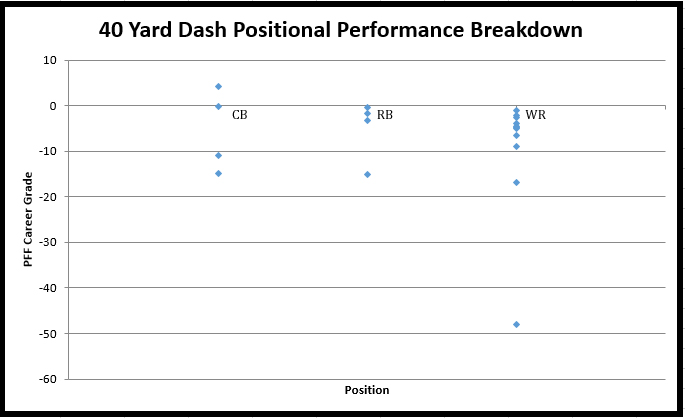
NFL Combine 40-Yard Dash Results Since 2009
Looking at the breakdown of players chosen, it is definitely wide receiver heavy with 12 of the 20 fastest players taken being receivers, with running backs and cornerbacks splitting the other eight. The majority of the players from all three positions were in the 0 to negative 10 range, with Darrius Heyward-Bey being the major outlier here with a career grade of negative 48.1.
Vertical Leap
Having a good vertical is a nice skill to have in football, but outside of receivers and defensive backs going up for a football, it doesn’t seem super necessary. Sure defensive lineman can leap to bat down passes or running backs can hurdle would-be tacklers, but that’s not something that happens frequently to most players.
The vertical leap is meant to be a test of a player’s explosiveness. It is a short test to show what kind of quick burst a player can produce. This theoretically has more use than simply how high the player can jump. For instance, if a player is explosive off the ball, he may be hard to keep in front of while trying to block. That instance doesn’t include jumping at all, but involves a lot of the muscles needed for jumping and having those muscles used in similar ways.

NFL Combine Vertical Leap Results Since 2009
Looking at the top 20 vertical performances at the combine, 23 players in total due to a tie for 20th, NFL GMs would seem to not put a lot of stock into the vertical as a necessary show of explosiveness or a useful skill. Only three of the 23 top vertical performers (13 percent) were taken in the first round and none of them have a positive PFF career grade.
Rounds one through three saw only eight of the 23 players taken with three of them having positive grades. Meaning three of the five players taken in rounds two and three of the draft have positive career grades. A seemingly high number since only three of the elite leapers were taken in the first round at all and none of them have positive career grades.
Overall six of the 23 players have positive career grades from PFF, good for 26 percent of the top vertical leapers from the combine.
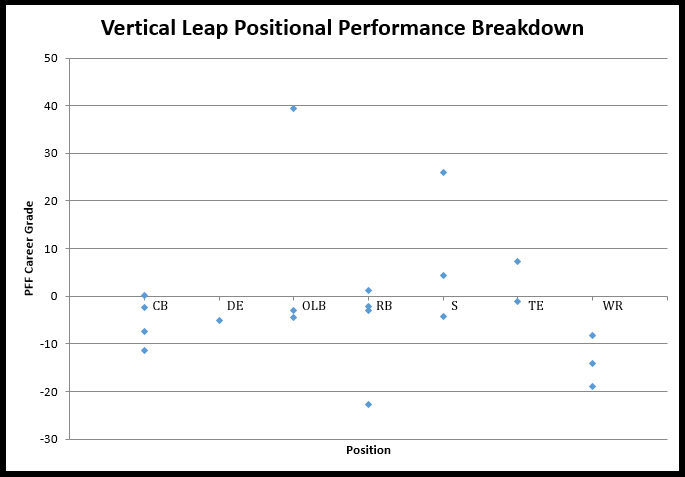
NFL Combine Vertical Leap Results Since 2009
Amazingly the 23 players that make up the top 20 vertical scores come from seven different positions, the most diverse event at the combine.
With running backs and wide receivers leading the way with five players each and cornerbacks close behind with four players in the top 23. Outside linebackers and safeties (3 each) followed by tight ends (2) and a defensive end round out that top 23.
Two of the three safeties that scored in the top 20 vertical performances since 2009 have positive career grades, (including an impressive 25.9 grade for Eric Berry) accounting for a third of all the positive grades scored for this event despite only having three people make it from the position.
Oddly enough the positions that would seem to benefit the most from a good vertical score, cornerbacks and wide receivers, only had a combined one positive grade and that one was merely a 0.2.
Short Shuttle
The short shuttle, like the vertical and a couple other tests, help to measure explosiveness. It also more importantly shows a player's ability to change direction and change their momentum quickly as well as show off their agility.
In my eyes the shuttle seems to be the most useful test in terms of being applicable to football. No matter the position, being agile and able to quickly change directions and accelerate is very important.

NFL Combine Short Shuttle Results Since 2009
The top twenty shuttle scores comprised of 23 total players, four of which were drafted in the first round. That ties for second among the events for first round picks. Of those four, two have produced positive career grades and have done so at very high rates with the two that have negative grades barely being below zero.
Ten of the 23 players were drafted in the first three rounds of the draft with four of them producing positive career grades. Those four positive grades came in the first two rounds with only six players from this event selected in that timeframe.
One of the top graded players out of the short shuttle group is the Green Bay Packers’ own second round pick, Casey Hayward, with a career grade of 23.5 from Pro Football Focus.
All together, six of the 23 players produced positive career grades, good for 26 percent.

NFL Combine Short Shuttle Results Since 2009
To no surprise, the shuttle event was dominated by the skill position players with wide receivers and cornerbacks taking 18 of the 23 spots and safeties coming in a distant second with three players. Running backs and outside linebackers fill out the last two spots with one player each.
Three-Cone Drill
Similar to the short shuttle, the three-cone drill measures how well a player changes directions. Where it differentiates itself is that is also shows how quickly a player can change direction and get back up to speed. A seemingly useful drill for lots of positions.
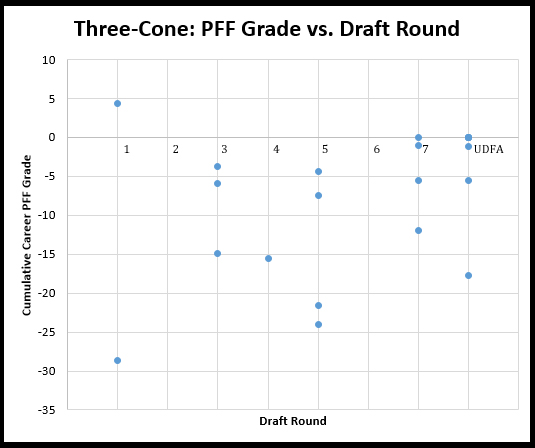
NFL Combine Three-Cone Drill Results Since 2009
The results, or lack there of, from the three-cone drill are very interesting. Only five of the 22 players were taken in the first three rounds of the draft, by far the lowest of any event, and only two of those five were taken in the first round. It seems that general managers do not put much stock into the three-cone drill.
The only player of the 22 on the list to rank with a positive career grade was one of the first round selections, Patrick Peterson.
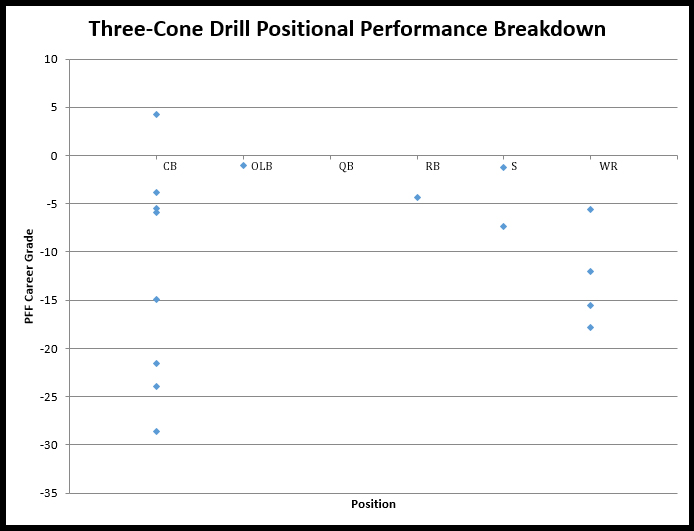
NFL Combine Three-Cone Drill Results Since 2009
The position breakdown of the top three-cone performers are heavily skewed towards wide receivers and cornerbacks. With nine cornerbacks and eight wide receivers as top performers, they combine to make up 77 percent of those in the top 20 performances for this event. There were two safeties taken and one of each from the outside linebackers, running backs, and quarterbacks.
Maybe even more surprising than the lack of positive scores, is how many very poor scores there are from wide receivers and cornerbacks. There are seven players from those two positions with a rating of lower than negative 10.
Broad Jump
Similar to the vertical leap, the broad jump is a test used to show explosiveness. It is a little more practical than the vertical leap when it comes to measuring explosiveness due to the player not only having to jump upwards, but move forward as well, a more applicable application of the muscle groups.

NFL Combine Broad Jump Results Since 2009
Next to the 40-yard dash, the broad jump is the event NFL GMs seems to put the most stock in. With 14 of the 24 players (58 percent) getting drafted in the first three rounds of the draft and four of those 14 were drafted in the first round. Amazingly of the four first round picks, three of them had positive grades with the highlight being Julio Jones who has a career grade of 35 despite all his injuries.
The second round saw six players selected but only one has a positive career grade, that one was the top broad jump performance since 2009 and he also has the top career grade of these players with 39.5. That player is outside linebacker Jamie Collins.
The 14 players drafted in the first three rounds produced five positive grades, meanwhile the other ten players produced three positive career grades for a total of eight out of the 24 players with positive career grades.

NFL Combine Broad Jump Results Since 2009
There were five positions taken of the 24 players, of those 24 players 15 of them were cornerbacks (8) and wide receivers (7). Safeties (4), running backs (3), and outside linebackers (2) round out the other nine players.
Despite 63 percent of the players selected being receivers or cornerbacks, four of the eight positive grades came from the six safeties or outside linebackers. In fact both of the outside linebackers to make the top 20 have positive grades.
Despite a very good percentage of players with positive grades (33 percent) only Julio Jones and Jamie Collins have a career grade over five. With all of the receivers and cornerbacks to finish in the top 20 of this event, only four finished with positive grades. Those two positions also have all of the poor grades for players from this event.
Bench Press
The bench press is a test that helps show a player’s upper-body strength and the endurance of their upper-body. This is a test that is very useful for offensive and defensive lineman and linebackers that want to be pass rushers.
Depending who you talk to you will get varying degrees of importance for this event because it is an advantage to have shorter arms since there is a shorter distance that the player needs to move the bar and long arms are typically a desirable trait to have in lineman.

NFL Combine Bench Press Results Since 2009
Due to bench reps being a discrete measurement instead of continuous, a lot of people were tied for the 20th highest score. Overall 26 players scored in the top 20 reps on the bench. Oddly, only one of them was selected in the first round of the draft (Russell Okung) and he has a positive grade with a solid 11.7 career grade.
In the first three rounds 11 players were selected and a very impressive eight of them have positive career grades, highlighted by Louis Vasquez’s 72.3 career grade.
Overall 10 players of the 26 have positive career grades, meaning only two of the 16 players selected after the third round have positive grades. This is clearly an event that caters well to players selected early in the draft and maybe holds a little more significance than some give it credit for, although there isn’t much there in terms of high end grades, just consistency.
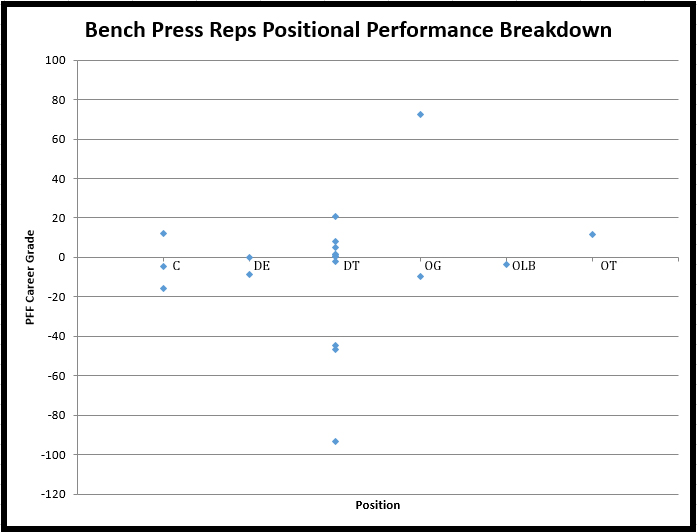
NFL Combine Bench Press Results Since 2009
All of the 26 players are on the offensive or defensive line, with the lone exception being outside linebacker Cornelius Washington. The majority of players are defensive tackles (12) and every other position (excluding Washington at OLB) had three players. You may only see one or two grades on the chart for some of the positions and that is because a handful of the guys didn’t see any NFL playing time to get graded.
Despite all of the players selected, Brandon Williams is the only defensive tackle to standout, with a score of 20.5 for a career grade. Meanwhile three of the 12 defensive tackles have horrible career grades well below 40.
Defensive tackle appears to be the only position that is strongly affected by an impressive showing on the bench press. With only three positive grades from the other 14 players outside of defensive tackle and only one real standout (Okung) and one real flop (Russell Bodine).
Multiple Top 20 Performers:
Looking at the top 20 performances of each of the six events totaled a combined 138 players. In those 138 players, 20 of them actually succeeded in finishing in the top 20 in two events, true freak athletes.
One of the 138 players, Josh Robinson, even finished in the top 20 of FOUR events since 2009. Josh Robinson is indeed the king of the combine and that performance is the reason why a short player with no ball skills or awareness was drafted in the 3rd round by the Minnesota Vikings. He has accumulated a career grade of -14.9 in his three-year career.
No player finished in the top 20 of more than four events and no player finished in the 20 in exactly three events. Meaning 21 players finished in the top 20 of more than one event (20 in two events, Josh Robinson in four events). Those 21 players combine to have only three positive career grades. Those players are outside linebacker Jamie Collins (39.5), safety David Bruton (4.3) and cornerback Patrick Peterson (4.3), all defensive players.
Jamie Collins and David Bruton both finished in the top 20 of the broad jump and vertical. Meanwhile Patrick Peterson finished in the top 20 in the 40-yard dash and three-cone drill, he is clearly a man that likes his hyphenated events. Peterson is the only player to have a positive career grade and finish in the top 20 for the 40-yard dash OR the three-cone drill.
It seems the players that are the elite of the elite in terms of athleticism are typically not good football players and are drafted for nothing more than their athleticism hopefully translating to the football field.
All Together
Looking at the chart showing all of the draft picks and the round they were drafted in for the top 20 performers of the six measurable skill events at the NFL Combine since 2009 shows a few trends:
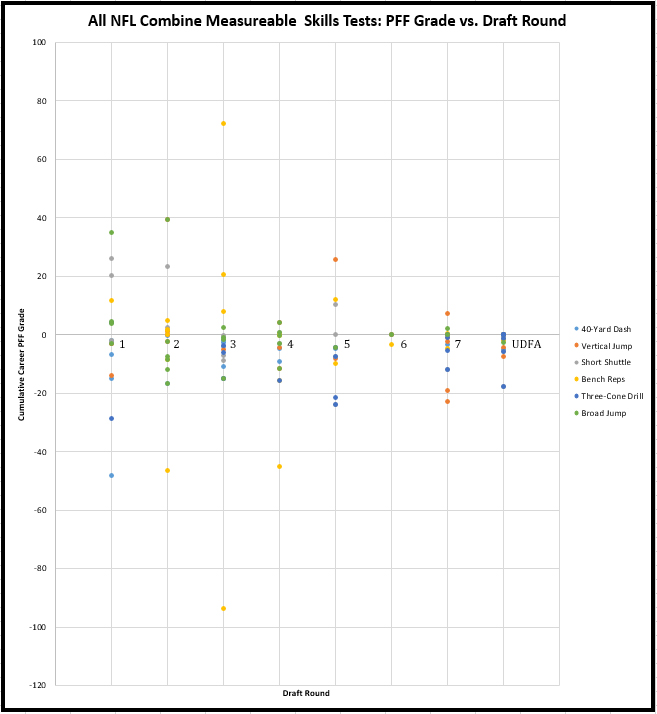
All Rounds NFL Combine round vs PFF Grade
The first one that you may notice is that as the draft goes on, the expected performance of these elitely skilled players condenses. The first round has a wide variety of performance that is very much spread out fairly evenly from the mid-30s to almost negative 50.
Move to the second round and there are a couple high level players and one poor performer with everyone else fit between a grade of 10 and negative 20. The third round sees the same thing, just a little more condensed. The fourth round is basically the same as the third but with no high level performers.
For whatever reason the fifth and sixth rounds are a little off, each for different reasons. The fifth round is more evenly spread out, basically like the first round without the high end performers and the overall flops. Meanwhile the sixth round only had four people drafted of the 138 used in this piece and only one of them even played in the NFL to register a grade by PFF (Cornelius Washington).
The 7th round sees many players bunched around zero with two poor performers and only one player to register a meaningful positive grade. Similarly the pool of undrafted free agents has most of the players just slightly below zero, with one poor performer and no positive grades. This is due in large part to undrafted free agents and seventh round picks not sticking around long in the NFL.
The top 13 player career grades in the first three rounds all come from players that excelled in the broad jump, shuttle, or bench press.
The bench press had a really bad performer taken in the 2nd and 3rd rounds, but other than that there were no major flops in the first three rounds from the broad jump, shuttle, or bench press.
Oddly the broad jump saw a bunch of players between negative five and negative 20 in the second round. Meanwhile there were no noticeably bad grades from the top shuttle players taken in the first three rounds.
If a team is going to look at taking a player early in the draft that shoots up the draft boards based on elite performance at the combine, I would be looking to take someone that dominated the shuttle event.
On the other side of the coin are the vertical, 40-yard dash, and three-cone drill. Three events that had totally different results.
The vertical was fairly bland, nothing really of note there.
However the three-cone drill seemed to be completely ignored by NFL general managers in the draft. Only five of the 22 players were taken in the first three rounds and only 14 of the 22 were even drafted with only one player having a positive career grade.
The 40-yard dash, despite all of its glory and being the seemingly number one looked at and talked about event, was awful. With a very high 13 of the 20 players taken in the first three rounds, the 40 topped all events with 65 percent of the players taken early. Despite all of those early drafted players, only one player out of the 20 has a positive career grade. Relying on the 40-yard dash is the event that gets GMs fired.
The majority of 138 players looked at were receivers and cornerbacks, pretty much all of the tests but the bench press relate to their positions. In fact 54 percent of the players (75 of the 138) were receivers or cornerbacks. Despite over half of the players being cornerback or receivers only a third of the positive grades (11 of 33) were from them.
Looking at all the top performers it seems to show that you are not likely to hit it out of the park by taking an elite combine performer and hoping they develop into a football player. Louis Vasquez is the only player of the 100+ players here to have an elite grade.
Despite all of the receivers and cornerbacks in this study, you do not see the elite likes of Antonio Brown, Jordy Nelson, A.J. Green, Calvin Johnson, Randall Cobb, Richard Sherman, or Chris Harris Jr. These are all players that are physically gifted, but more so are good football players. They have very good athleticism, just not elite, and because of this they don’t need to rely on that athleticism to succeed.
Take Jordy Nelson for example. He ran a 4.51 in the 40 at the combine, that would have him ranked 250th since 2009. Antonio Brown was just a fraction of a second faster at 4.50 seconds and no one considers either of them to be slow or "average" speed receivers. Everyone who has watched Jordy play knows that he has good speed, it's not elite, but it's definitely good or "good enough." When you take a player with "good enough" speed that understands the game and knows how to run his routes to get himself open, he goes from a guy with 4.51 speed to a guy that plays like he has 4.35 speed. A 4.51 40-yard dash is not slow, so if he can get a step on you, it will be hard, if not impossible, to catch up.
This is where Jordy Nelson's combine results would have ended up ranked since 2009:
40-yard dash: 4.51 seconds (250th)
3-Cone Drill: 7.03 seconds (396th)
Shuttle: 4.35 seconds (536th)
Vertical: 31" (817th)
Broad Jump: 123" (205th)
I don't think anyone considers Jordy to not be athletic. Often times "good enough" measurables is all the player needs if they know how to play the game. Teams do not need to overpay for the top-end athletes hoping they develop into football players, but rather get value in the draft by getting the good/productive football players that are "good enough" athletes to transition to the NFL.
Those ranks also put into perspective just how much of a freak athlete Josh Robinson is to finish in the top 20 in four events and Jordy cannot crack the top 200 in any.
GMs should be drafting based on football skill, not measurable skill, and (they) don’t don’t don’t (have to necessarily) believe the hype.
PLEASE SUBSCRIBE TO OUR CHEESEHEAD NATION WEEKLY NEWSLETTER HERE.
__________________________
"Jersey Al" Bracco is the Editor-In-Chief, part owner and wearer of many hats for CheeseheadTV.com and PackersTalk.com. He is also a recovering Mason Crosby truther. Follow Al on twitter at @JerseyalGBP.
__________________________



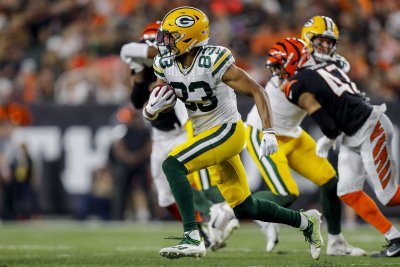
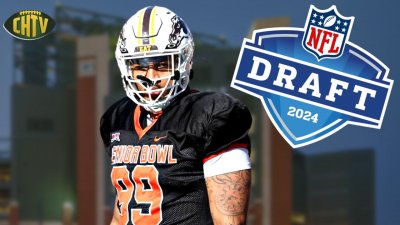
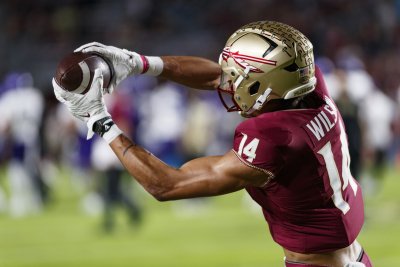
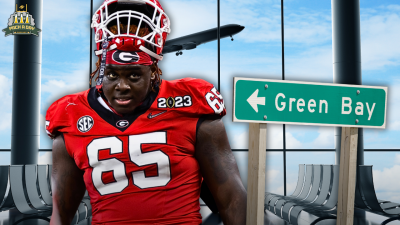






Comments (14)
TKWorldWide
June 21, 2015 at 08:39 pm
Is this going to lead to "fans" clamoring that GB trade Jordy for Josh Robinson?
I hope not.
AZPack
June 21, 2015 at 09:04 pm
The combine and its measures are just one of many tools that NFL scouts and GM's use to evaluate talent. Its not intended to be used as a predictor of success. To use it as such is not understanding why the combine is even in place, which for the teams has as much to do w/ checking on injury concerns and talking to combine participants in person in a more relaxed and informal setting than a conference or board room.
The measures the NFL test at the combine help evalutate athletic ability, which is one of the many evaluations scouts use when making an evaluation of a player. They can generally see who has the most athletic ability during games. the combine reinforces and helps differentiate between 2 similarly graded players.
TXBadger
June 21, 2015 at 10:37 pm
Good article. I didn't see this article earlier so I'm glad that it was reprinted. I'd also like to see a comparison of the best performances by position. That way we could see if the short shuttle is a determination of success for OL more than for LBs, etc.
jeremyjjbrown
June 21, 2015 at 10:49 pm
Nice Article.
Ted has said before that they use the combine events to confirm what they already think about players. The fact that teams overreach based on the drill numbers is probably good for the Packers.
There is an important aspect to the combine that is not drills. The Interviews and football concepts whiteboarding is a really good way from the teams to assess the personality fit and football IQ of prospects.
jeremyjjbrown
June 22, 2015 at 12:15 pm
Is there someone who just shows up here and downvotes every post?
LeagueObsrvr
June 22, 2015 at 12:06 am
This article reminded me of former Eagles DE Mike Mamula. He was taken in the first round of the 1995 draft largely on his herculean performance at the combine that year. He went on to be a complete bust...
Amanofthenorth
June 22, 2015 at 04:19 am
For D Forced fumbles Is a stat that never gets talked about but judging off of the all time leaders of this category it's a superstar thing.
Idiot Fan
June 22, 2015 at 09:10 am
Very interesting article. It's great to have the PFF grades for use here. It's very helpful to have a tangible, if imperfect, measure of career success, rather than try to create some measure based on starts, pro bowls, etc. As someone mentioned above, it would be great to dump ALL of the PFF grades and combine results available into a model and see, by position, which numbers, if any, were statistically significant in terms of correlation or predictive power.
John Galt III
June 22, 2015 at 10:17 am
If you do an analysis of players staying and performing in the NFL, the correlation is very high by draft round, but it is still somewhat subjective. Scout A for the Packers may have a different opinion of Player X than Scout C of the Bengals.
When you look at the grades of players after the draft in so far as what different scouts said about them, the comments are all over the place. I have seen NFC North scout say, "this guy is an immediate starter" while an AFC South guy says, " this player has some major problems and will be a work in progress".
We have all seen these comments. The Combine, the film analysis, player interviews, the college coach interviews and so forth all have room for differences of opinion.
I'm not sure if any team will ever be great at drafting perfectly because so much is hidden from view and is also the result of biases on the part of scouts, coaches and GM's.
Idiot Fan
June 22, 2015 at 11:11 am
Yeah, I agree with all that. I was just thinking that, if you have a PFF career grade for each player, as well as combine numbers, then you could create a model that would bypass the subjective stuff, using PFF career grade as the dependent variable, and the combine numbers as the various independent variables.
But yes, some stuff we will never be able to quantify. Who is John Galt?
Thegreatreynoldo
June 23, 2015 at 01:44 am
He is us.
MikeReuter
June 22, 2015 at 11:18 am
That's definitely something I wanted to do, but a couple issues arise when looking at it.
The first being that a lot of the superstar QB/WR talent only perform certain events. For instance, guys like Dez Bryant skip most events they know they aren't great in or just skip the combine all together. I could do it with pro days, but then you run into other problems because not everyone's pro day is performed at the same place/time (although that's not a huge issue).
The bigger issue for why I didn't just look at everyone is that PFF only shows you one player at a time and/or one year at a time (unless I'm missing something). So I can only see who was the best players each year, not over a combination of years. You also can only see one year at a time for a certain player. For this piece I looked up each of these players individually and then added up their total PFF scores myself because PFF doesn't give you a career score for a player.
But as I write this out, I may have figure out a way to do it. It will be a ton of work to get all of the combine stuff formatted properly with the PFF stuff in Excel, but I'll see if I can do a full model, I'm really interested to see what it would look like.
Idiot Fan
June 22, 2015 at 11:21 am
That makes sense. Maybe we can find someone in the CHTV family who has the skills to hack the PFF database and download the whole data file :).
J0hn Denver's Gavel
June 22, 2015 at 10:14 am
This article was tailored for everyone's favorite Viking fan, "Ben."